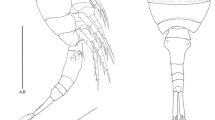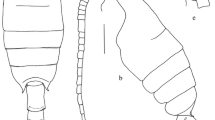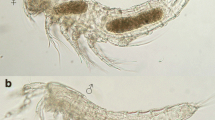Abstract
Coordinated research efforts in mesophotic coral reefs are only a decade old, but have already produced exciting findings in ecology, physiology, geomorphology, population genetics, biodiversity, and taxonomy. In this taxonomic contribution, we describe both sexes of a new copepod species of the family Novocriniidae Huys and Iliffe in Zool Scr 27(1):1–15, 1998 from a mesophotic coral reef off southwestern Puerto Rico. This is only the fifth species of the family and the fourth of the genus Atergopedia Martínez Arbizu and Moura in Zool Beitr NF 38:189–210, 1998. The new species, Atergopedia dowgialli sp. nov., shares the following characters with its three congeners: 1) antenna without seta on the first endopodal segment; 2) lateral armature of the female antenna shows a multiplication of distinct setae and consists of one geniculate seta followed by five or more slender setae; 3) the first endopod segment of the first swimming leg P1 bears no inner seta; 4) male fifth leg with two spines on endopodal lobe; and 5) the exopod of the fifth swimming leg fused to basendopod in the female. Atergopedia dowgialli sp. nov. is characterized by the loss of the basal seta in both antenna and maxilliped, the loss of the first maxilla endite, the presence of a long process between the outer and distal elements of the leg 1 exopodite 3, which is stronger and longer in the female, and the possession of a very short and strongly ornamented furca in both sexes. The genus Atergopedia has been found in deep and relatively shallow habitats from the Arctic Ocean to the Caribbean. In contrast, almost all species of the taxon Novocrinidimorpha, which includes the families Novocriniidae, Superornatiremidae Huys 1996, and Rotundiclipeidae Huys 1988, have been found associated with anchialine caves, indicating a derived distribution for Atergopedia.






Similar content being viewed by others
References
Ballantine DL, Ruiz H (2010) Two new deepwater Peyssonnelia species, Peyssonnelia iridescens and Peyssonnelia gigaspora (Peyssonneliaceae, Rhodophyta) from Puerto Rico, Caribbean Sea. Phycologia 49:537–544
Ballantine DL, Ruiz H (2011) A new encrusting deep-water coral reef alga, Peyssonnelia incomposita (Peyssonneliaceae, Rhodophyta), from Puerto Rico, Caribbean Sea. Cryptogam Algol 32:19–26
Boxshall GA, Jaume D (1999) Discoveries of cave misophrioids (Crustacea: Copepoda) shed new light on the origin of anchialine cave faunas. Zool Anz 239:1–19
Corgosinho PHC, Schizas NV (2013) Archeolourinia shermani, a new genus and species of Louriniidae (Copepoda: Harpacticoida) from a Caribbean mesophotic zone. J Mar Biol Assoc UK 93:651–657
Danielopol DL (1990) The origin of the anchialine cave fauna - the "deep sea" versus the "shallow water" hypothesis tested against the empirical evidence of the Thaumatocyprididae (Ostracoda). Bijdragen tot de Dierkunde 60(3/4):137–143
Danielopol DL, Baltanas A, Bonaduce G (1996) The darkness syndrome in subsurface-shallow and deep-sea dwelling Ostracoda (Crustacea). In: Uiblein F, Ott J, Stachowitsch M (eds) Deep-sea and extreme shallow-water habitats: affinities and adaptations. Austrian Academy of Sciences, Vienna, pp 123–143
Ferrari FD, Ivanenko VN (2008) The identity of protopodal segments and the ramus of maxilla2 of copepods (Copepoda). Crustaceana 81:823–835
Filatov N, Pozdnyakov D, Johannessen OM, Pettersson LH, Bobylev LP (2005) White sea: its marine environment and ecosystem dynamics influenced by global change. Jointly published with Praxis Publishing, UK, p 1–476
Gage JD, Tyler PA (1991) Deep-sea biology: a natural history of organisms at the deep-sea floor. Cambridge University Press, Cambridge, pp 1–504
George KH (2004) Description of two new species of Bodinia, a new genus incertae sedis in Argestidae Por, 1986 (Copepoda, Harpacticoida), with reflections on argestid colonization of the Great Meteor Seamount plateau. Org Divers Evol 4(4):241–264
Gheerardyn H, Martinez-Arbízu P, Vanreusel A (2009) Discovery of Novocriniidae (Copepoda, Harpacticoida) from cold-water corals in the Porcupine Seabight (NE Atlantic), with description of a new species of Atergopedia. Org Divers Evol 9(3):248.e1–248.e12
Hart CW, Manning RB Jr, Iliffe TM (1985) The fauna of Atlantic marine caves: Evidence of dispersal by sea floor spreading while maintaining ties to deep waters. Proc Biol Soc Wash 98(1):288–292
Hennig W (1966) Phylogenetic systematics. University of Illinois Press, Urbana
Huys R, Boxshall GA (1991) Copepod evolution. The Ray Society, London
Huys R, Iliffe TM (1998) Novocriniidae, a new family of harpacticoid copepods from anchihaline caves in Belize. Zool Scr 27(1):1–15
Iliffe TM (1990) Crevicular dispersal of marine cave faunas. Mem Biospeol 17:93–96
Iliffe TM (2000) Anchialine cave ecology. In: Ecosystems of the world 30. Subterranean Ecosystems. Elsevier, p 59–76
Iliffe TM, Kornicker LS (2009) Worldwide diving discoveries of living fossil animals from the depths of anchialine and marine caves. Smithson Contrib Mar Sci 38:269–280
Kahng SE, Garcia-Sais JR, Spalding HL, Brokovich E, Wagner D, Weil E, Hinderstein L, Toonen RJ (2010) Community ecology of mesophotic coral reef ecosystems. Coral Reefs 29:255–275
Kornev PN, Chertoprud EC (2008) Copepod crustaceans of the order harpacticoida of the white sea. Morphology, systematics, ecology. Biology Faculty, Moscow State University. Tovarishchestvo Nauchmikh Izdanii, KMK, Moscow, p 1–370
Locker SD, Armstrong RA, Battista TA, Rooney J, Sherman C, Zawada DG (2010) Geomorphology of Mesophotic Coral Ecosystems. Coral Reefs 29:329–345
Martínez Arbizu P, Moura G (1998) Atergopediidae, a new family of harpacticoid copepods (Crustacea) from oligotrophic Arctic sediments. Zool Beitr NF 38:189–210
Pesic V, Chatterjee T, Schizas NV (2012) A new species of Pontarachna (Acari, Hydrachnidia, Pontarachnidea) from a mesophotic coral ecosystem off Vieques Island, Puerto Rico, Caribbean Sea. Zootaxa 3440:63–67
Petrescu I, Chatterjee T, Schizas NV (2012) New genus and new species of Cumaceans (Crustacea: Peracarida: Cumacea) from the mesophotic coral ecosystem of SW Puerto Rico, Caribbean Sea. Zootaxa 3476:55–61
Petrescu I, Chatterjee T, Schizas NV (2013) Two new species of the genus Cumella (Crustacea: Cumacea: Nannastacidae) associated with mesophotic reefs of Puerto Rico and St. Croix, Caribbean Sea. Cah Biol Mar 54:257–262
Schizas NV, Dahms H-U, Kangtia P, Corgosinho PHC, Galindo Estronza A (2015) A new species of Longipedia Claus, 1863 (Copepoda: Harpacticoida: Longipediidae) from Caribbean mesophotic reefs with remarks on the phylogenetic affinities of Polyarthra. Mar Biol Res. doi:10.1080/17451000.2015.1013556
Seifried S (2003) Phylogeny of Harpacticoida (Copepoda): Revision of 'Maxillipedasphalea' and Exanechentera. Cuvillier Verlag, Göttingen, pp 1–259
Seifried S, Schminke HK (2003) Phylogenetic relationships at the base of Oligoarthra (Copepoda, Harpacticoida) with a new species as the cornerstone. Org Divers Evol 3(1):13–37
Sherman C, Nemeth M, Ruíz H, Bejarano I, Appeldoorn R, Pagán F, Schärer M, Weil E (2010) Geomorphology and benthic cover of mesophotic coral ecosystems of the upper insular slope of southwest Puerto Rico. Coral Reefs 29:347–360
Stock JH (1986) Deep sea origin of Cave Faunas, an unlikely supposition. Stygologia 2:105–111
Acknowledgments
The UPRM-CCRI-DMS technical rebreather divers (C. Sherman, M. Nemeth, I. Bejarano, H. Ruiz, M. Carlos) collected all samples. Partial funding was provided by the National Oceanographic and Atmospheric Administration Coastal Ocean Programs under award #NA06NOS4780190 to the Department of Marine Sciences, University of Puerto Rico at Mayagüez.
Author information
Authors and Affiliations
Corresponding author
Additional information
Communicated by P. Martinez Arbizu
This article is registered in ZooBank under urn:lsid:zoobank.org:pub:A9906259-0E93-467D-8C34-FAEA840314AE
Rights and permissions
About this article
Cite this article
Corgosinho, P.H.C., Schizas, N.V. & Alfaro Lozano, M. A new species of Atergopedia (Copepoda: Harpacticoida: Novocriniidae) from a Caribbean mesophotic reef. Mar Biodiv 46, 841–852 (2016). https://doi.org/10.1007/s12526-016-0446-9
Received:
Revised:
Accepted:
Published:
Issue Date:
DOI: https://doi.org/10.1007/s12526-016-0446-9




